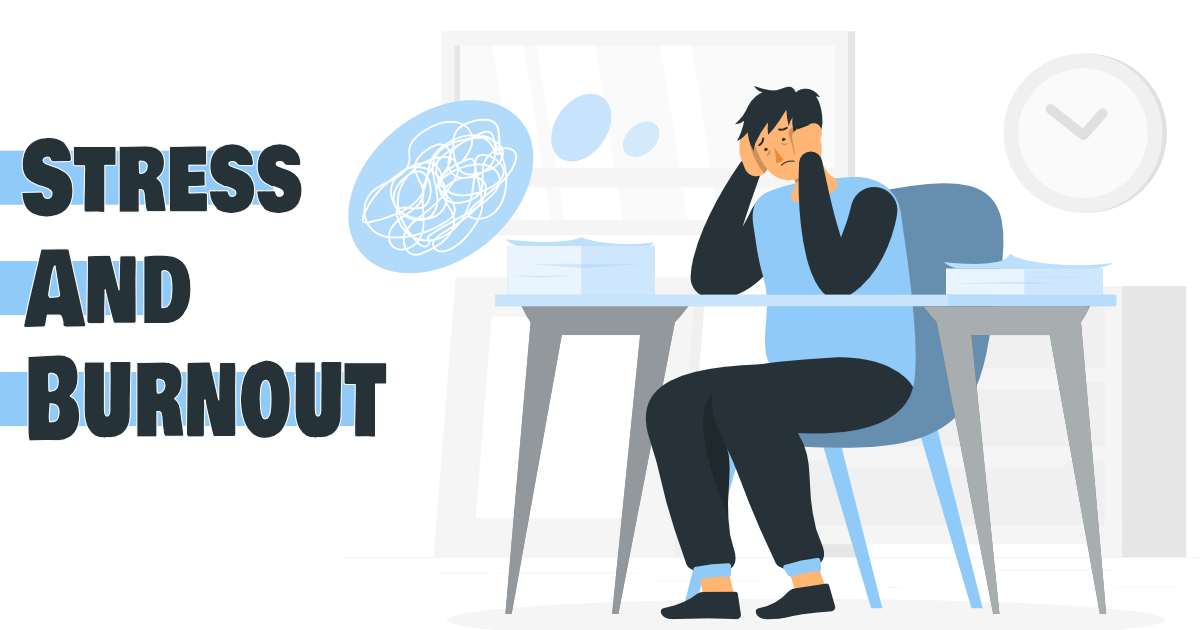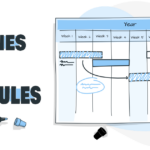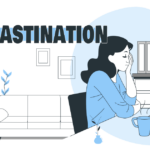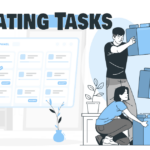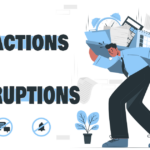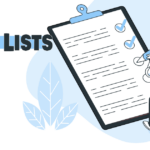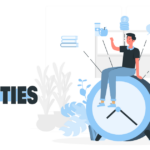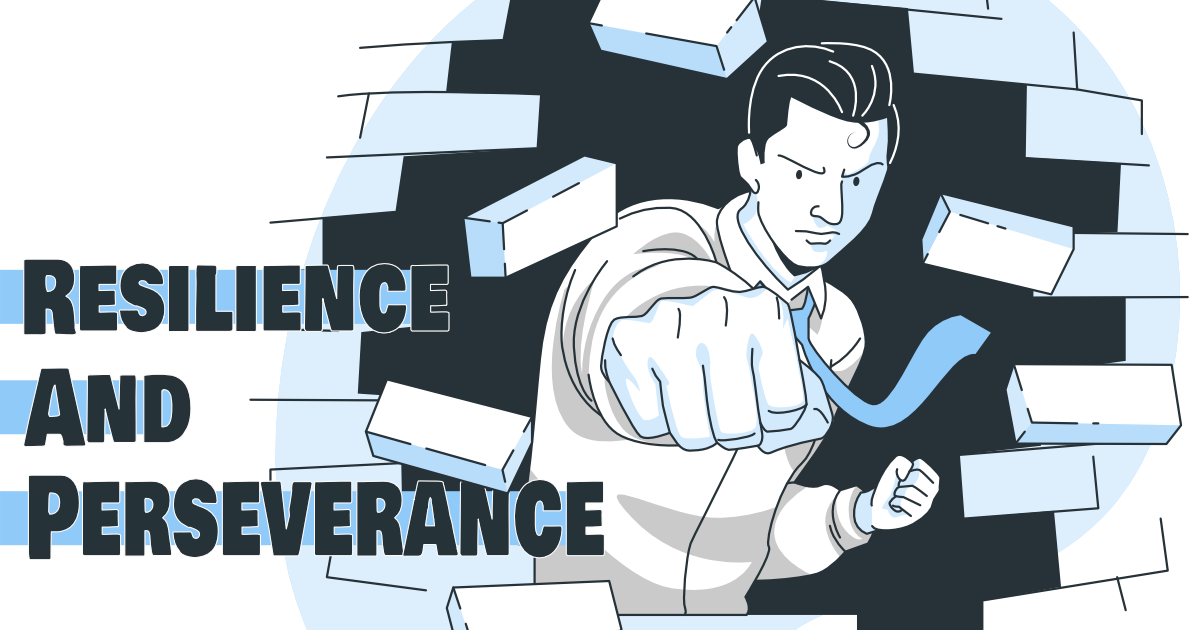Stress and burnout are common challenges faced by individuals in today’s fast-paced world. It’s crucial to recognize the signs of stress and take proactive steps to manage it, as stress left unchecked can lead to burnout. In this sub-topic, we’ll explore various strategies and techniques for managing stress and avoiding burnout, helping individuals maintain a healthy work-life balance and achieve their goals. Whether it’s through self-care practices, stress-management techniques, or seeking professional help, it’s essential to prioritize one’s mental and emotional well-being to lead a productive and fulfilling life.
Identifying sources of stress
Stress is a common and natural response to challenges, pressures and changes in life. It can impact our mental, physical and emotional well-being. Therefore, it is important to identify the sources of stress and manage them effectively.
What are the sources of stress?
The sources of stress are different for everyone and can range from work, relationships, financial concerns, health issues to daily hassles. It is essential to recognize what triggers stress for you and understand the root cause.
Why is it important to identify sources of stress?
By identifying sources of stress, you can better understand what is causing your stress and take steps to manage it effectively. This can help you avoid burnout, maintain your well-being, and improve your quality of life.
How to identify sources of stress?
Here is a step-by-step guide to identify sources of stress:
- Keep a stress journal: Record your daily activities and stressors in a journal. This can help you identify patterns and triggers.
- Monitor your physical and emotional reactions: Pay attention to how your body responds to stress. Common physical reactions include headaches, fatigue, and muscle tension. Emotional reactions can include anxiety, irritability, and mood swings.
- Ask yourself: What is causing the stress? Take some time to reflect on what is causing your stress and why.
- Evaluate your lifestyle: Examine your daily habits and routines. Are there changes you can make to reduce stress?
Relevant Real-life Scenarios
- A young professional who is stressed due to work pressure and long working hours can identify their sources of stress as work-related and long working hours.
- A stay-at-home mom who is stressed due to managing household chores and taking care of children can identify her sources of stress as household responsibilities and parenting.
Best Practices
- Practice mindfulness and relaxation techniques such as deep breathing, yoga, and meditation to reduce stress and increase self-awareness.
- Seek support from friends, family, or a mental health professional if necessary.
- Engage in stress-relieving activities such as exercise, hobbies, and social activities.
Tools
- Stress journal
- Mobile apps for mindfulness and relaxation
- Online therapy services
Actionable Tips
- Prioritize self-care and engage in stress-relieving activities regularly
- Set realistic expectations and boundaries
- Seek support and communicate your stressors with friends and family
- Take breaks and engage in leisure activities
- Learn coping skills and problem-solving techniques
Conclusion
Identifying sources of stress is the first step to effectively manage stress and avoid burnout. By paying attention to your physical and emotional reactions, reflecting on what causes your stress, and making changes to your lifestyle, you can better understand your stressors and take steps to reduce them. Incorporating mindfulness and relaxation techniques, seeking support, engaging in stress-relieving activities, and learning coping skills can help you maintain your well-being and improve your quality of life.
Practicing self-care and stress-management techniques
Self-care and stress-management techniques are essential tools to help individuals manage stress and avoid burnout. By taking care of oneself, individuals can not only reduce stress levels, but also improve overall well-being and performance. In this article, we will discuss the various self-care and stress-management techniques that individuals can incorporate into their daily routine to help manage stress and avoid burnout.
Step-by-Step Guide
- Identifying Self-Care and Stress-Management Techniques: The first step to incorporating self-care and stress-management techniques into one’s routine is to identify which techniques work best for you. Some individuals may find meditation and deep breathing to be effective stress-management techniques, while others may prefer exercise, journaling, or spending time in nature.
- Making Time for Self-Care and Stress-Management Techniques: Once you have identified the self-care and stress-management techniques that work best for you, it is important to set aside time for these activities in your schedule. This could mean dedicating a few minutes each day for meditation or exercise, or setting aside a designated time each week to engage in a stress-management activity.
- Incorporating Self-Care and Stress-Management Techniques into Daily Routine: Once you have set aside time for self-care and stress-management techniques, it is important to make these activities a part of your daily routine. This can be done by making self-care and stress-management techniques a non-negotiable part of your daily schedule. For example, you can start your day with a few minutes of meditation or end your day with a relaxing yoga session.
- Regular Practice: It is important to regularly practice self-care and stress-management techniques to reap their benefits. Regular practice will not only help reduce stress levels but also improve overall well-being and performance.
Examples and Real-Life Scenarios
- John, a software engineer, finds that taking a 10-minute break every hour to stretch and move around helps him manage stress and avoid burnout.
- Sarah, a marketing executive, incorporates a 30-minute yoga session into her daily routine to help manage stress levels and improve her focus and productivity.
Best Practices
- Set aside dedicated time for self-care and stress-management activities
- Make self-care and stress-management activities a non-negotiable part of your daily routine
- Regularly practice self-care and stress-management techniques to reap their benefits
Tools and Actionable Tips
- Incorporate self-care and stress-management techniques into your daily routine, such as starting your day with a few minutes of meditation or ending your day with a relaxing yoga session.
- Make self-care and stress-management techniques a non-negotiable part of your daily schedule.
- Use apps or websites to track progress and monitor your self-care and stress-management techniques.
Conclusion
Incorporating self-care and stress-management techniques into one’s daily routine can help individuals manage stress and avoid burnout. By identifying which techniques work best for you, setting aside dedicated time for these activities, and making these activities a part of your daily routine, individuals can improve their overall well-being and performance. Regular practice of self-care and stress-management techniques is key to reaping their benefits.
Incorporating physical activity and exercise
Physical activity and exercise play a crucial role in managing stress and avoiding burnout. Regular physical activity not only improves physical health but also has a positive impact on mental health. Engaging in physical activity helps to release endorphins, reduce stress, and improve mood.
Step-by-Step Guide
- Determine your fitness goals: Before incorporating physical activity into your routine, it is essential to determine what you want to achieve through exercise. Whether it is to build strength, increase endurance, or improve flexibility, having clear goals will help you stay motivated and on track.
- Assess your current fitness level: Knowing your current fitness level will help you choose activities that are appropriate for your ability and avoid injury. You can take a simple fitness test or consult with a healthcare professional or fitness expert to assess your fitness level.
- Create a schedule: Incorporate physical activity into your daily routine by scheduling it at a time that works best for you. This can be first thing in the morning, during lunchtime, or after work. Consistency is key, so aim to stick to the same schedule as much as possible.
- Choose activities that you enjoy: It is important to choose physical activities that you enjoy, as this will make it easier to stick to your exercise routine. This could be anything from going for a walk, playing a sport, taking a dance class, or even going to the gym.
- Vary your routine: To avoid boredom and prevent burnout, it is crucial to mix things up by varying your routine and trying new activities. This will keep your body and mind engaged and prevent you from hitting a plateau.
- Make it social: Exercise is more enjoyable and less of a chore when done with others. Consider joining a sports team, working out with friends, or taking a class at a gym or community center.
Why and How?
Physical activity and exercise help to reduce stress by releasing endorphins, which are natural mood elevators, and lowering cortisol levels, the stress hormone. Engaging in physical activity also helps to improve mood, increase energy levels, and reduce feelings of anxiety and depression.
Relevant Examples and Real-Life Scenarios
- A study conducted by the American Psychological Association found that regular exercise can be as effective as medication in treating depression and anxiety.
- A busy office worker who spends long hours sitting in front of a computer can benefit greatly from incorporating physical activity into their daily routine. This can include a morning yoga session, a lunchtime walk, or an after-work gym session.
Best Practices, Tools, and Actionable Tips
- Make physical activity a priority by scheduling it into your daily routine.
- Find a physical activity that you enjoy and make it a habit.
- Gradually increase intensity and duration as you build up your fitness level.
- Mix it up by incorporating a variety of physical activities into your routine.
- Use a fitness app or website to track your progress and set goals.
- Try different activities to find what you enjoy the most.
- Set realistic and achievable goals and reward yourself when you reach them.
- Keep a journal to record your progress and feelings.
- Consult with a healthcare professional or fitness expert to assess your fitness level and develop a safe and effective exercise program.
Conclusion
Incorporating physical activity and exercise into your daily routine is an effective way to manage stress and avoid burnout. Regular physical activity not only improves physical health but also has a positive impact on mental health by reducing stress, improving mood, and increasing energy levels. By making physical activity a priority, finding an activity that you enjoy, and gradually increasing intensity, you can effectively manage stress and avoid burnout.
Staying organized and prioritizing tasks
Staying organized and prioritizing tasks is crucial to manage stress and avoid burnout. An organized work schedule and to-do list can help to simplify your life and reduce the feeling of being overwhelmed. When you prioritize tasks, you are able to focus on the most important items first and complete them efficiently, leading to a sense of accomplishment and less stress.
Step 1: Identify all tasks
The first step is to identify all the tasks that need to be done. Write down everything that comes to mind, no matter how small or insignificant it may seem. You can use a notebook, a to-do list app, or a whiteboard to capture all the tasks.
Step 2: Categorize tasks into priorities
Once you have identified all the tasks, it’s time to categorize them into different priority levels. You can use a simple three-level system of high, medium, and low priority to start. High-priority tasks are those that need to be done immediately and cannot be postponed. Medium-priority tasks are those that need to be done within a few days. Low-priority tasks are those that can be postponed or delegated to someone else.
Step 3: Make a daily to-do list
Based on the priority level, make a daily to-do list. Start with the high-priority tasks and move down the list. Focus on completing the most important tasks first, as this will give you a sense of accomplishment and reduce stress.
Step 4: Allocate time for each task
It’s essential to allocate time for each task on your to-do list. This will help you to manage your time effectively and ensure that you stay on track. You can use a time-tracking app or a simple timer to keep track of the time spent on each task.
Step 5: Review and adjust your to-do list regularly
Regularly review and adjust your to-do list to ensure that you stay on track. If new tasks come up, add them to your list and prioritize them. If you find that some tasks are no longer relevant, remove them from your list.
Best Practices
- Break down large tasks into smaller, more manageable ones
- Use a calendar to schedule appointments and important deadlines
- Set aside specific times for checking email and answering phone calls
- Take regular breaks to prevent burnout
Tools
- Todoist
- Trello
- Google Keep
- Asana
Actionable Tips
- Start each day by making a to-do list
- Focus on one task at a time
- Don’t be afraid to delegate tasks
- Avoid multitasking
Conclusion
Staying organized and prioritizing tasks is an essential step in managing stress and avoiding burnout. By following these simple steps and utilizing tools and best practices, you can simplify your life and reduce the feeling of being overwhelmed. Regularly reviewing and adjusting your to-do list can help you stay on track and achieve your goals.
Maintaining a healthy work-life balance
Balancing work and personal life is crucial to avoid stress and burnout. A healthy work-life balance ensures that individuals can perform optimally in both aspects of their lives and have a sense of control over their schedules. This article will focus on how to maintain a healthy work-life balance and its benefits.
Step-by-Step Guide
- Set clear boundaries between work and personal time: Define the hours during which you will be working and the hours you will dedicate to your personal life. This could involve setting specific times for checking email, answering calls, and other work-related tasks. It’s also important to communicate these boundaries to your coworkers and family to ensure they are respected.
- Prioritize self-care: Make time for activities that bring you joy, relaxation, and rejuvenation. This could be as simple as reading a book, taking a walk, or pursuing a hobby. Prioritizing self-care helps to reduce stress and increase overall well-being.
- Create a flexible schedule: Allowing for flexibility in your schedule can help you to balance work and personal life more effectively. This could involve working from home, taking breaks during the day, or adjusting your work schedule to accommodate personal commitments.
- Delegate tasks: Delegating tasks to coworkers or hiring help for personal tasks can free up time for work-life balance. This could involve delegating tasks at work, or hiring a cleaner or personal assistant for home-related tasks.
- Avoid overcommitting: Saying ‘no’ to commitments that will overly tax your schedule can prevent burnout. It’s important to identify your priorities and focus on what is most important, rather than trying to do everything.
Examples
- A working parent who prioritizes self-care by taking a yoga class once a week to reduce stress and maintain a healthy work-life balance.
- An individual who sets clear boundaries by not checking email or taking work calls during personal time in the evenings and weekends.
Best Practices
- Regularly reflect on the balance between work and personal life to identify areas that need improvement.
- Set achievable goals and prioritize tasks to avoid feeling overwhelmed.
- Make time for family and friends to maintain strong relationships and support systems.
Tools
- Time-management apps such as Todoist or Trello can help to organize tasks and prioritize work-life balance.
- Mindfulness and meditation apps such as Headspace or Calm can assist in reducing stress and promoting self-care.
Actionable Tips
- Take regular breaks throughout the day to recharge and refocus.
- Plan fun activities or events outside of work to look forward to and break up the work week.
- Find ways to incorporate physical activity into your daily routine, such as taking a walk during lunch or going to the gym after work.
Conclusion
Maintaining a healthy work-life balance is crucial for avoiding stress and burnout. By setting clear boundaries, prioritizing self-care, creating a flexible schedule, delegating tasks, and avoiding overcommitting, individuals can effectively balance work and personal life. Regular reflection, goal setting, and utilizing tools such as time-management apps can also assist in maintaining a healthy work-life balance.
Seeking support from family, friends, and professional resources
Stress and burnout can have severe consequences on an individual’s mental and physical health. As much as one tries to manage stress on their own, seeking support from loved ones, friends, and professional resources is equally important. Having a strong support system can help individuals overcome challenges and manage stress more effectively.
Step-by-Step Guide
- Identifying the need for support: It is essential to recognize when stress and burnout have become overwhelming and it is time to seek support. Signs such as persistent feelings of anxiety, depression, irritability, and fatigue indicate that it is time to seek help.
- Reaching out to family and friends: A support system made up of family and friends can provide comfort and reassurance during difficult times. It is okay to reach out to loved ones for support and share feelings and concerns.
- Utilizing professional resources: When stress and burnout become severe, seeking the help of a mental health professional is advisable. A therapist can provide guidance and support, and offer coping strategies for managing stress.
- Joining support groups: Joining a support group can be helpful as individuals can connect with others who may be facing similar challenges and share their experiences.
Examples
- A working mother who is struggling to balance work and family life may reach out to her partner or a close friend for support and advice.
- An individual who is dealing with job-related stress may see a therapist to receive professional help and guidance on how to manage the stress.
- A person struggling with burnout may join a support group for individuals dealing with similar issues and find comfort in sharing experiences with others.
Best Practices
- Establish open communication with loved ones and friends and share feelings and concerns.
- Seek professional help if stress and burnout become severe and unmanageable.
- Utilize online resources and support groups for individuals facing similar challenges.
- Seek support from loved ones, friends, and professional resources regularly to manage stress effectively.
Tools
- Online counseling services such as BetterHelp and Talkspace.
- Mental health apps such as Headspace, Calm, and Moodfit.
- Online support groups such as 7 Cups and Anxiety UK.
Actionable Tips
- Write down what causes stress and anxiety, and identify triggers.
- Reach out to a trusted friend or family member when feeling overwhelmed.
- Take advantage of mental health resources offered by employers or insurance providers.
- Practice self-care and make time for activities that bring joy and relaxation.
Conclusion
Stress and burnout can have a significant impact on an individual’s mental and physical well-being. Seeking support from loved ones, friends, and professional resources is essential in managing stress effectively. Building a strong support system can provide comfort and reassurance during difficult times and help individuals overcome challenges.
Staying mindful and present
Incorporating mindfulness and being present in the moment can help individuals manage stress and avoid burnout. Mindfulness involves paying attention to one’s thoughts, feelings, and physical sensations in the present moment, without judgment. This awareness can help individuals identify when stress levels are rising and respond in a healthier way.
Step 1: Practice Mindfulness Meditation
Mindfulness meditation is a technique that involves focusing on the present moment and allowing thoughts and feelings to pass by without judgment. This can be done through various practices, such as deep breathing exercises, guided meditations, or body scans. Start with a few minutes a day and gradually increase the time as you get more comfortable.
Step 2: Incorporate Mindful Breathing Throughout the Day
Incorporating mindful breathing exercises throughout the day can help individuals stay present and calm in the moment. This can be as simple as taking a few deep breaths when feeling stressed or overwhelmed. Additionally, setting reminders throughout the day to take a few mindful breaths can help individuals incorporate this practice into their daily routine.
Step 3: Engage in Mindful Activities
Engaging in activities that require focus and concentration can help individuals stay present and reduce stress levels. Examples include coloring, knitting, or engaging in a hobby that requires full attention.
Step 4: Practice Self-Reflection
Take time to reflect on your thoughts, feelings, and experiences. This can be done through journaling, meditating, or simply taking a few minutes to reflect each day. Self-reflection can help individuals identify sources of stress and develop strategies to manage them more effectively.
Step 5: Surround Yourself with Positive Influences
Surrounding oneself with positive influences, such as supportive friends and family, can help reduce stress levels and promote a sense of well-being. Additionally, engaging in activities with others, such as exercise or social events, can help individuals stay connected and reduce feelings of isolation and burnout.
Best Practices
- Start with small steps and gradually increase the time spent practicing mindfulness.
- Incorporate mindfulness into daily activities and routines.
- Surround yourself with positive influences.
- Take breaks and engage in activities that bring joy and relaxation.
Actionable Tips
- Start a gratitude journal and take time each day to reflect on the things you are thankful for.
- Incorporate mindfulness breathing exercises into your daily routine.
- Practice self-reflection and identify sources of stress.
- Take time to engage in activities that bring joy and relaxation.
- Seek support from family, friends, or professional resources if needed.
Conclusion
Incorporating mindfulness and being present in the moment can help individuals manage stress and avoid burnout. By following the steps outlined above, individuals can develop a routine that promotes well-being and reduces stress levels. Remember to be patient with yourself, and seek support from friends, family, and professional resources if needed.
Taking breaks and stepping away from work
Work can be incredibly stressful and demanding, leading to burnout and reduced productivity. To avoid these negative outcomes, it’s crucial to take breaks and step away from work. Taking breaks can provide an opportunity to rest and recharge, which can help boost energy levels and improve mental and emotional well-being. This article will explain the importance of taking breaks and stepping away from work and provide a step-by-step guide on how to do so effectively.
The human brain was not designed to work continuously for extended periods. Taking regular breaks can provide the brain with a much-needed rest, leading to increased focus, creativity, and productivity. Regular breaks can also help reduce stress, which is a common side effect of a heavy workload. When stress levels are high, it can be challenging to stay focused and motivated, leading to decreased productivity and burnout. By taking breaks and stepping away from work, individuals can reduce stress levels, recharge their batteries, and return to work feeling refreshed and ready to tackle the next task.
Here’s a step-by-step guide on how to effectively take breaks and step away from work:
- Schedule your breaks: Schedule time for breaks during the day and stick to this schedule. It’s essential to make time for breaks, as this can help prevent burnout and increase productivity.
- Take short breaks regularly: Take short breaks throughout the day, such as every hour or two. This can help reduce stress and increase energy levels.
- Get up and move: Use your breaks to get up and move around. This can help reduce stress, boost energy levels, and improve overall well-being.
- Engage in relaxing activities: Use your breaks to engage in relaxing activities, such as reading a book, meditating, or listening to music.
- Disconnect from work: During breaks, it’s essential to disconnect from work and avoid checking emails or completing work tasks.
- Take a vacation: Taking a vacation is an excellent way to step away from work and recharge. Taking time off work can help reduce stress, increase creativity, and improve overall well-being.
Examples and Real-Life Scenarios
- A software engineer, after a long day of coding, takes a 10-minute break every hour to stretch, walk, and drink water. This helps her reduce stress, boost energy levels, and stay focused.
- A teacher, who is feeling overwhelmed and stressed, takes a one-week vacation to visit her family. This helps her recharge and return to work feeling refreshed and ready to tackle the next task.
Best Practices
- Make time for breaks and stick to the schedule.
- Take short breaks throughout the day to reduce stress and increase energy levels.
- Use breaks to get up and move around, engage in relaxing activities, and disconnect from work.
- Take a vacation to step away from work and recharge.
Tools
- Time management apps, such as Todoist, can help schedule breaks and track progress.
- Relaxation apps, such as Headspace, can provide guided meditation and mindfulness exercises to help reduce stress.
Actionable Tips
- Take short breaks throughout the day, such as every hour or two.
- Use your breaks to get up and move around, engage in relaxing activities, and disconnect from work.
- Schedule time for a vacation to step away from work and recharge.
Conclusion
Taking breaks and stepping away from work is an essential component of managing stress and avoiding burnout. Regularly taking time away from work allows individuals to recharge, refocus, and return to work with renewed energy and perspective. It also provides an opportunity to engage in activities that promote self-care and stress-management techniques. There are various methods for taking breaks, including taking a walk, engaging in physical activity, meditating, or simply disconnecting from work-related tasks. It is important to find what works best for you and make it a regular part of your routine. By incorporating breaks and stepping away from work into your daily routine, you can manage stress, increase productivity, and reduce the risk of burnout.
Setting boundaries and avoiding overworking
In today’s fast-paced world, it’s easy to get caught up in work and sacrifice other important aspects of our lives. Overworking can lead to burnout and have a negative impact on our mental and physical health. It’s essential to set boundaries and avoid overworking to maintain a healthy work-life balance.
Step 1: Identify your priorities
To set effective boundaries, you need to first understand your priorities. What are the things in life that are most important to you? This could be your health, family, personal interests, or anything else that brings you joy and fulfillment. By knowing your priorities, you can make sure that work does not interfere with them.
Step 2: Set realistic goals and expectations
Once you have identified your priorities, set realistic goals and expectations for work. Make sure your goals are aligned with your values and priorities, and avoid taking on too much work that will interfere with your personal life. It’s important to remember that you cannot do everything and that it’s okay to say no to tasks that will negatively impact your well-being.
Step 3: Establish boundaries
Establishing boundaries is key to avoiding overworking. This could include setting a specific time to stop work each day, limiting after-hours work, and taking breaks throughout the day. Consider using tools like time tracking software to monitor your work habits and ensure you are staying within your established boundaries.
Step 4: Practice self-care
Self-care is essential to avoiding overworking and maintaining a healthy work-life balance. This could include exercise, meditation, hobbies, or anything that helps you recharge and feel refreshed. Make sure to schedule time for self-care into your routine and stick to it just as you would with any other important appointment.
Step 5: Seek support
Finally, don’t be afraid to seek support from family, friends, and professional resources. Talking to someone about the stress and pressure you are feeling can help you find new strategies to cope with work-related stress and avoid overworking.
Best practices
- Make a to-do list and prioritize tasks
- Turn off notifications and minimize distractions
- Set a specific time each day to disconnect from work
- Take breaks and step away from work regularly
- Schedule time for self-care activities
Conclusion
Setting boundaries and avoiding overworking are crucial steps in maintaining a healthy work-life balance. By identifying your priorities, setting realistic goals, establishing boundaries, practicing self-care, and seeking support, you can reduce stress and avoid burnout. Remember to take care of yourself, and prioritize your well-being.
Seeking professional help if necessary
While stress and burnout can often be managed through lifestyle changes and self-care practices, sometimes professional help may be necessary. There are many resources available to help individuals address stress and burnout, including therapy, counseling, and support groups.
Step-by-Step Guide
- Assess the severity of your stress and burnout: Before seeking professional help, it’s important to assess the severity of your stress and burnout. If you are having trouble managing stress on your own, or if your stress and burnout are affecting your daily life and relationships, it may be time to seek professional help.
- Research different types of professional help: There are many different types of professional help available for individuals struggling with stress and burnout. Some options include therapy, counseling, support groups, and medical treatment. Research different options to determine what type of help is right for you.
- Find a qualified professional: Look for a qualified professional who has experience working with individuals struggling with stress and burnout. Consider factors such as their qualifications, training, and reviews from previous clients when making your decision.
- Start talking: Once you have found a qualified professional, start talking. Share your experiences and feelings with them, and work together to determine the best course of action. This may involve working through past experiences, learning stress management techniques, or addressing any underlying mental health conditions.
- Make it a priority: Attending therapy or counseling is an important step in managing stress and burnout, so make it a priority. Be consistent in your attendance and follow through with the recommended course of action.
Examples and Best Practices
- If you are experiencing burnout, consider reaching out to a therapist who specializes in burnout recovery.
- If you have a history of anxiety or depression, consider attending therapy or counseling to address any underlying mental health conditions that may be contributing to your stress and burnout.
- Support groups can be a helpful resource for individuals struggling with stress and burnout. They provide a safe and supportive environment where individuals can share their experiences and support each other through difficult times.
Actionable Tips
- Write down what you want to discuss with your therapist or counselor before your appointment. This will help you make the most of your time together.
- If you’re feeling nervous about starting therapy or counseling, remind yourself of the reasons why you decided to seek professional help in the first place.
- Remember that therapy and counseling are long-term investments in your mental and emotional well-being, so stick with it and don’t give up if it takes time to see progress.
Conclusion
Seeking professional help can be a valuable step in managing stress and avoiding burnout. Whether it’s therapy, counseling, or a support group, professional resources can provide individuals with the tools and support they need to effectively manage stress and overcome burnout. By working with a qualified professional, individuals can develop coping strategies and gain insight into their experiences, helping them to achieve a greater sense of balance and well-being.
Resources and References
- “The Mindfulness Solution to Pain: Step-by-Step Techniques for Chronic Pain Management” by Lynne Raymond
- “The Power of Now: A Guide to Spiritual Enlightenment” by Eckhart Tolle
- “The Anxiety Survival Guide for Teens: CBT-Based Skills to Overcome Fear, Worry, and Panic” by Jennifer Shannon
- “The Power of Habit: Why We Do What We Do in Life and Business” by Charles Duhigg
- “Spark: The Revolutionary New Science of Exercise and the Brain” by John J. Ratey
- “The Exercise Cure: A Doctor’s All-Natural, No-Pill Approach to Better Health and Longer Life” by Jordan Metzl
- “Getting Things Done: The Art of Stress-Free Productivity” by David Allen
- “The Pomodoro Technique” by Francesco Cirillo
- “The Power of Habit: Why We Do What We Do in Life and Business” by Charles Duhigg
- “Essentialism: The Disciplined Pursuit of Less” by Greg McKeown
- “The Relaxation and Stress Reduction Workbook” by Martha Davis, Elizabeth Robbins Eshelman, and Matthew McKay
- “The 7 Habits of Highly Effective People: Powerful Lessons in Personal Change” by Stephen Covey
- “The Art of Stress-Free Productivity” by Susan Clark
- “The Stress-Proof Brain: Master Your Emotional Response to Stress Using Mindfulness and Neuroplasticity” by Melanie Greenberg
- “Mindfulness: An Eight-Week Plan for Finding Peace in a Frantic World” by Mark Williams and Danny Penman
- “The Mindful Way Through Depression” by Mark Williams, John Teasdale, Zindel Segal, and Jon Kabat-Zinn
- “The Power of Full Engagement” by Jim Loehr and Tony Schwartz
- “Boundaries: When to Say Yes, How to Say No To Take Control of Your Life” by Henry Cloud and John Townsend
- “The Mindful Way Through Stress: The Proven 8-Week Path to Health, Happiness, and Well-Being” by Susan Woods, J. Mark G. Williams, and John Teasdale
- “The Burnout Society” by Byung-Chul Han
- “The Self-Care Solution: A Modern Guide to Stress-Free Living” by Shannon Fox
